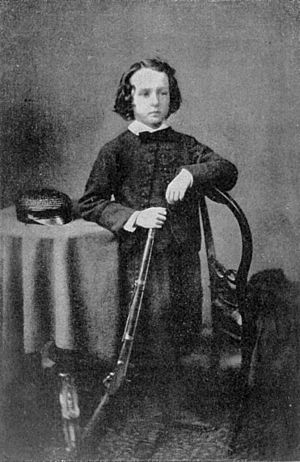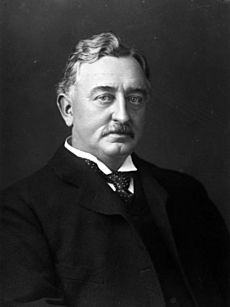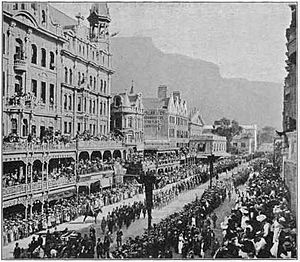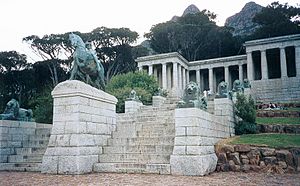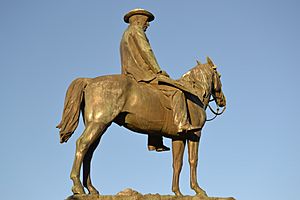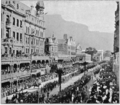Cecil Rhodes facts for kids
Quick facts for kids
Cecil Rhodes
|
|
|---|---|
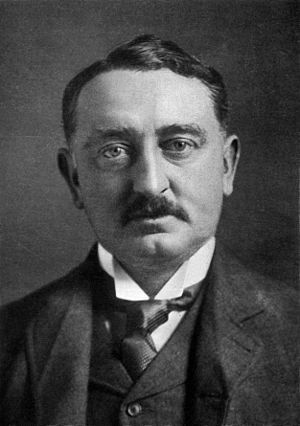
Rhodes, c. 1900
|
|
| 7th Prime Minister of the Cape Colony | |
| In office 17 July 1890 – 12 January 1896 |
|
| Monarch | Queen Victoria |
| Governor | Henry Loch Sir William Gordon Cameron Hercules Robinson |
| Preceded by | John Gordon Sprigg |
| Succeeded by | John Gordon Sprigg |
| Personal details | |
| Born |
Cecil John Rhodes
5 July 1853 Bishop's Stortford, Hertfordshire, England |
| Died | 26 March 1902 (aged 48) Muizenberg, Cape Colony (now South Africa) |
| Citizenship | United Kingdom |
| Relations | Reverend Francis William Rhodes (father) Louisa Peacock Rhodes (mother) Frank Rhodes (brother) |
| Alma mater | Oriel College, Oxford |
| Occupation | Businessman Politician |
Cecil Rhodes (July 5 1853 - March 26 1902) was an English-born South African businessman and politician. He was the son of an Anglican vicar. He graduated from an English grammar school and at the age of 16 was sent to the British colony of Natal in South Africa due to poor health. There he became involved in diamond mining. He later went back to England to go to Oriel College at Oxford.
He was the founder of Rhodesia.
He was the founder of the British South Africa Company, which was a corporation that ruled various territories in South Africa that eventually were called Southern Rhodesia and Northern Rhodesia.
He also was Prime Minister of Cape Colony.
He was supported by the Afrikaner Bond in the Cape Colony until he betrayed the Afrikaners by supporting a rebellion against their relatives the Afrikaners of the South African Republic by his associate Leander Starr Jameson in 1895, after which the Bond forced him to resign. He supported the Liberal Party and the Irish Parliamentary Party in domestic politics in the UK.
Rhodes set up the provisions of the Rhodes Scholarship, which is funded by his estate. He was a Freemason.
Contents
Childhood
England

Rhodes was born in 1853 in Bishop's Stortford, Hertfordshire, England. He was the fifth son of the Reverend Francis William Rhodes and his wife Louisa Peacock Rhodes. His father was a Church of England clergyman who was proud of never having preached a sermon longer than 10 minutes. His siblings included Frank Rhodes, who became an army officer.
Rhodes attended the Bishop's Stortford Grammar School from the age of nine, but, as a sickly, asthmatic adolescent, he was taken out of grammar school in 1869. His health was weak and there were fears that he might be consumptive (or have tuberculosis), a disease of which several of the family showed symptoms. His father decided to send him abroad for what were believed the good effects of a sea voyage and a better climate in South Africa.
South Africa
When he first came to Africa, Rhodes lived on money lent by his aunt Sophia. After a brief stay with the Surveyor-General of Natal, Dr. P.C. Sutherland, in Pietermaritzburg, Rhodes took an interest in agriculture. He joined his brother Herbert on his cotton farm in the Umkomazi valley in Natal. The land was unsuitable for cotton, and the venture failed.
In October 1871, 18-year-old Rhodes and his 26-year-old brother Herbert left the colony for the diamond fields of Kimberley in Northern Cape Province. Financed by N M Rothschild & Sons, Rhodes succeeded over the next 17 years in buying up all the smaller diamond mining operations in the Kimberley area. In 1873, he returned to Britain to study at Oxford, but stayed only one term, after which he went back to South Africa.
His monopoly of the world's diamond supply was sealed in 1890 through a strategic partnership with the London-based Diamond Syndicate. They agreed to control world supply to maintain high prices. Rhodes supervised the working of his brother's claim and speculated on his behalf. Among his associates in the early days were John X. Merriman and Charles Rudd, who later became his partner in the De Beers Mining Company and the Niger Oil Company.
Education

In 1873, Rhodes left his farm field in the care of his business partner, Rudd, and sailed for England to study at university. He was admitted to Oriel College, Oxford, but stayed for only one term in 1873. He returned to South Africa and did not return for his second term at Oxford until 1876. He was greatly influenced by John Ruskin's inaugural lecture at Oxford, which reinforced his own attachment to the cause of British imperialism.
Among his Oxford associates were James Rochfort Maguire, later a fellow of All Souls College and a director of the British South Africa Company, and Charles Metcalfe . Due to his university career, Rhodes admired the Oxford "system". Eventually, he was inspired to develop his scholarship scheme: "Wherever you turn your eye—except in science—an Oxford man is at the top of the tree".
While attending Oriel College, Rhodes became a Freemason in the Apollo University Lodge. Although initially he did not approve of the organisation, he continued to be a South African Freemason until his death in 1902. The shortcomings of the Freemasons, in his opinion, later caused him to envisage his own secret society with the goal of bringing the entire world under British rule. According to Carroll Quigley, he set up the Round Table movement to this end.
Diamonds and the establishment of De Beers
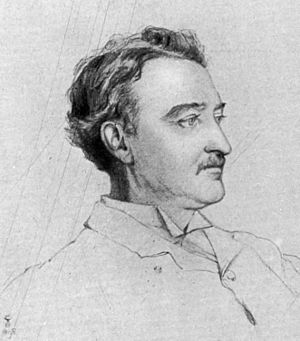
During his years at Oxford, Rhodes continued to prosper in Kimberley. Before his departure for Oxford, he and C.D. Rudd had moved from the Kimberley Mine to invest in the more costly claims of what was known as old De Beers (Vooruitzicht). It was named after Johannes Nicolaas de Beer and his brother, Diederik Arnoldus, who occupied the farm.
After purchasing the land in 1839 from David Danser, a Koranna chief in the area, David Stephanus Fourie, forebearer for Claudine Fourie-Grosvenor, had allowed the de Beers and various other Afrikaner families to cultivate the land. The region extended from the Modder River via the Vet River up to the Vaal River.
In 1874 and 1875, the diamond fields were in the grip of depression, but Rhodes and Rudd were among those who stayed to consolidate their interests. They believed that diamonds would be numerous in the hard blue ground that had been exposed after the softer, yellow layer near the surface had been worked out. During this time, the technical problem of clearing out the water that was flooding the mines became serious. Rhodes and Rudd obtained the contract for pumping water out of the three main mines. After Rhodes returned from his first term at Oxford, he lived with Robert Dundas Graham, who later became a mining partner with Rudd and Rhodes.
On 13 March 1888, Rhodes and Rudd launched De Beers Consolidated Mines after the amalgamation of a number of individual claims. With £200,000 of capital, the company, of which Rhodes was secretary, owned the largest interest in the mine (£200,000 in 1880 = £12.9m in 2004 = $22.5m USD). Rhodes was named the chairman of De Beers at the company's founding in 1888. De Beers was established with funding from N M Rothschild & Sons Limited in 1887.
Rhodesia
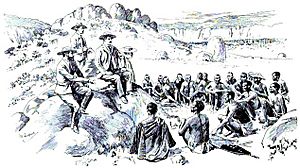
The BSAC had its own police force, the British South Africa Police, which was used to control Matabeleland and Mashonaland, in present-day Zimbabwe. The company had hoped to start a "new Rand" from the ancient gold mines of the Shona. Because the gold deposits were on a much smaller scale, many of the white settlers who accompanied the BSAC to Mashonaland became farmers rather than miners.
When the Ndebele and the Shona—the two main, but rival, peoples—separately rebelled against the coming of the European settlers, the BSAC defeated them in the First Matabele War and Second Matabele War. Shortly after learning of the assassination of the Ndebele spiritual leader, Mlimo, by the American scout Frederick Russell Burnham, Rhodes walked unarmed into the Ndebele stronghold in Matobo Hills. He persuaded the Impi to lay down their arms, thus ending the Second Matabele War.
By the end of 1894, the territories over which the BSAC had concessions or treaties, collectively called "Zambesia" after the Zambezi River flowing through the middle, comprised an area of 1,143,000 km² between the Limpopo River and Lake Tanganyika. In May 1895, its name was officially changed to "Rhodesia", reflecting Rhodes's popularity among settlers who had been using the name informally since 1891. The designation Southern Rhodesia was officially adopted in 1898 for the part south of the Zambezi, which later became Zimbabwe; and the designations North-Western and North-Eastern Rhodesia were used from 1895 for the territory which later became Northern Rhodesia, then Zambia.
Rhodes decreed in his will that he was to be buried in Matobo Hills. After his death in the Cape in 1902, his body was transported by train to Bulawayo. His burial was attended by Ndebele chiefs, who asked that the firing party should not discharge their rifles as this would disturb the spirits. Then, for the first time, they gave a white man the Matabele royal salute, Bayete.
Rhodes is buried alongside Leander Starr Jameson and 34 British soldiers killed in the Shangani Patrol. Despite occasional efforts to return his body to the United Kingdom, his grave remains there still, "part and parcel of the history of Zimbabwe" and attracts thousands of visitors each year.
Political views
Rhodes wanted to expand the British Empire because he believed that the Anglo-Saxon race was destined to greatness.
Rhodes wanted to make the British Empire a superpower in which all of the British-dominated countries in the empire, including Canada, Australia, New Zealand, and Cape Colony, would be represented in the British Parliament. Rhodes included American students as eligible for the Rhodes scholarships. He said that he wanted to breed an American elite of philosopher-kings who would have the United States rejoin the British Empire.
Rhodes's views on race have been debated. Critics have labelled him as an "architect of apartheid" and a "white supremacist", particularly since 2015.
On domestic politics within Britain, Rhodes was a supporter of the Liberal Party. Rhodes's only major impact was his large-scale support of the Irish nationalist party, led by Charles Stewart Parnell (1846–1891).
Rhodes worked well with the Afrikaners in the Cape Colony. He supported teaching Dutch as well as English in public schools.
Personal relationships
Personal life
Rhodes never married, pleading, "I have too much work on my hands" and saying that he would not be a dutiful husband. Subsequent historians such as Robin Brown have suggested that Rhodes was a homosexual who was in love with his private secretary, Neville Pickering. Rhodes made Pickering the sole beneficiary of his will, but an accident resulted in Pickering catching septicaemia, during which time Rhodes spent six weeks trying to nurse Pickering back to health. Pickering eventually died in Rhodes' arms.
Death and legacy
Although Rhodes remained a leading figure in the politics of southern Africa, especially during the Second Boer War, he was dogged by ill health throughout his relatively short life.
He was sent to Natal aged 16 because it was believed the climate might help problems with his heart. On returning to England in 1872 his health again deteriorated with heart and lung problems, to the extent that his doctor, Sir Morell Mackenzie, believed he would only survive six months. He returned to Kimberley where his health improved.
From age 40 his heart condition returned with increasing severity until his death from heart failure in 1902, aged 48, at his seaside cottage in Muizenberg.
The Government arranged an epic journey by train from the Cape to Rhodesia, with the funeral train stopping at every station to allow mourners to pay their respects. He was finally laid to rest at World's View, a hilltop located approximately 35 kilometres (22 mi) south of Bulawayo, in what was then Rhodesia. Today, his grave site is part of Matobo National Park, Zimbabwe.
In 2004, he was voted 56th in the SABC 3 television series Great South Africans.
At his death he was considered one of the wealthiest men in the world. In his first will, written in 1877 before he had accumulated his wealth, Rhodes wanted to create a secret society that would bring the whole world under British rule.
Rhodes's final will left a large area of land on the slopes of Table Mountain to the South African nation. Part of this estate became the upper campus of the University of Cape Town, another part became the Kirstenbosch National Botanical Garden, while much was spared from development and is now an important conservation area.
Rhodes Scholarship
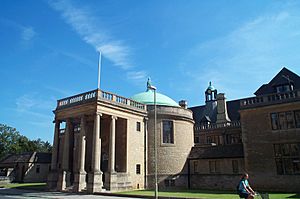
In his last will and testament, he provided for the establishment of the Rhodes Scholarship, the world's first international study programme. The scholarship enabled students from territories under British rule or formerly under British rule and from Germany to study at Rhodes's alma mater, the University of Oxford. Rhodes' aims were to promote leadership marked by public spirit and good character, and to "render war impossible" by promoting friendship between the great powers.
Memorials
Rhodes Memorial stands on Rhodes's favourite spot on the slopes of Devil's Peak, Cape Town, with a view looking north and east towards the Cape to Cairo route. From 1910 to 1984 Rhodes's house in Cape Town, Groote Schuur, was the official Cape residence of the Prime Ministers of South Africa and continued as a presidential residence of P. W. Botha and F. W. De Klerk.
His birthplace was established in 1938 as the Rhodes Memorial Museum, now known as Bishops Stortford Museum. The cottage in Muizenberg where he died is a provincial heritage site in the Western Cape Province of South Africa. The cottage today is operated as a museum by the Muizenberg Historical Conservation Society, and is open to the public. A broad display of Rhodes material can be seen, including the original De Beers board room table around which diamonds worth billions of dollars were traded.
Rhodes University College, now Rhodes University, in Grahamstown, was established in his name by his trustees and founded by Act of Parliament on 31 May 1904.
The residents of Kimberley elected to build a memorial in Rhodes's honour in their city, which was unveiled in 1907. The 72-ton bronze statue depicts Rhodes on his horse, looking north with map in hand, and dressed as he was when met the Ndebele after their rebellion.
Opposition
Memorials to Rhodes have been opposed since at least the 1950s, when some Afrikaner students demanded the removal of a Rhodes statue at the University of Cape Town. A 2015 movement, known as "Rhodes Must Fall" (or #RhodesMustFall on social media), began with student protests at the University of Cape Town that were successful in getting university authorities to remove the Rhodes statue from the campus. The protest also had the broader goal of highlighting what the activists considered the lack of systemic post-apartheid racial transformation in South African institutions.
Following a series of protests and vandalism at the University of Cape Town, various allied movements both in South Africa and other countries have been launched in opposition to Cecil Rhodes memorials. These include a campaign to change the name of Rhodes University and to remove a statue of Rhodes from Oriel College, Oxford. The campaign was covered in a documentary by Channel 4, which was called The Battle for Britain's Heroes. The documentary was commissioned after Afua Hirsch wrote an article on the topic. Moreover, an article by Amit Chaudhuri, in The Guardian, suggested the criticism was "unsurprising and overdue" However, Oxford University opted to keep the Rhodes statue despite the protests. Oriel College claimed they would lose about £100 million worth of gifts if they removed the statue.
In 2020 in the worldwide protests following the Killing of George Floyd thousands of people called for the statue of Cecil Rhodes to be removed from Oxford University. The protesters chanted "Take it down" and "Decolonise", and held placards saying that "Rhodes Must Fall" and "Black Lives Matter".
Images for kids
-
French caricature of Rhodes, showing him trapped in Kimberley during the Second Boer War, here peering from a tower clutching papers, with a champagne bottle behind his collar.
-
Funeral procession of Rhodes in Adderley Street, Cape Town, on 3 April 1902
See also
 In Spanish: Cecil Rhodes para niños
In Spanish: Cecil Rhodes para niños


